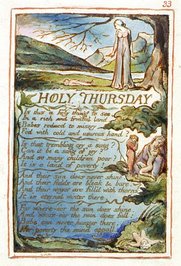measuring the metre
Whitman was one of the pioneers of “free verse,” believing the organic energy of the poetic impulse to be too important to be confined within the then-established metrical conventions. A self-taught individualist, he seemed to feel that if he followed others’ rules too slavishly he would fall into the sterile pattern-making of the hack versifier.
Although we can analyse the metrical shape of Patrol(l)ing Barnegat, whose structure does demonstrate more regularity than much of his other work, we do need to be aware of this ambivalence Whitman felt towards all orthodoxies.
scanning the poem
The difficulty of scanning Patroling Barnegat begins with its opening words. The convention we have inherited from classical times is to divide each line into “feet,” each “foot” containing one accented (or, less precisely, “stressed”) syllable and at least one unaccented (“unstressed”) syllable.
For example, the “iambic pentameter”, which is the form best known to GCSE students and a favourite of English poets, can be scanned thus:
Five (penta) “feet”, each of one “iamb”: i.e. one unaccented syllable plus one accented syllable, as in Keats’ Lamia:
she WAS / a GOR / -dian SHAPE / of DAZZ / -ling HUE,
verMIL / -ion SPOTT / -ed, GOL / -den, GREEN / and BLUE
[ Feet divided by slashes; accented syllables in capitals ]
For the fastidious, the last part of “vermilion” could be scanned as two syllables (li – on), and is typical of rhythmical variation within the established metre.
defying classical orthodoxies
Paul Fussell, in The Princeton Encyclopedia of Poetry and Poetics (PUP 1974), points out that “disagreement over the nature (and even the ‘existence’) of the foot has been traditional since the late Renaissance.”
However, that knowledge does not really help us in the GCSE, whose examiners tend to be happier with one-size-fits-all analyses.
Fussell also regards it as “perhaps unfortunate” that we have borrowed our terminology from the classical Greeks, as this leads to our trying to force analytical measures onto English shapes for which they may not be properly fitted.
identifying Whitman’s monosyllabic feet
Aware of Fussell's encouragement, we would seem perverse were we to scan the two opening words of Patrolling Barnegat (“Wild, wild”) as other than two fully-accented syllables each of full length – i.e. as two separate monosyllabic feet; “storm” also begs to be accented. Once again, although they run one after another, the three syllables “sea high runn” would seem to demand individual accenting. Thus, we produce the pattern:
WILD, WILD the STORM, and the SEA HIGH RUNNing,
which has a spring all of its own, with no reference to regular forms of the hexameter (or six-foot line).
playing with dactyls
The second line seems to fall into six feet of three syllables each:
STEAdy the / ROAR of the / GALE, with in / -CESSant / UNdertone / MUTTering,
[We call a foot comprising accented + unaccented + unaccented syllables a “dactyl”]
However, by introducing a break, or “caesura”, in the middle of his third foot and by missing out the third syllable in his fourth foot, Whitman avoids the monotonous “tumpity tumpity” rhythms that dactyls can impose upon English verse. With their drive from the start of each foot, the dactyls offer us a sense of the unremitting power of the waves, while the breaks remind us subconsciously of the storm’s unpredictability.
infusing energy
Again, the third line seems to scan best as six dactyls, with a caesura replacing the last syllable of the third foot.
For his fourth line, Whitman echoes the pattern of his first, opening with two full monosyllabic feet, continuing with three dactyls and finishing with an accented + unaccented two-syllable foot (a “trochee”):
WAVES,/ AIR, / MIDnight, their / SAVagest / TRINity / LASHing,
Every line of Patrolling Barnegat except the final one can be scanned as being of six feet, although some with their vigorous cascades of syllables might read more effectively with seven or even eight accents. Whitman confounds conventional scansion, because the energy he is trying to infuse into the spoken word depends more upon the stresses, the changing speeds, the timbre and other qualities of the reader’s voice.
shifting patterns
The shifting patterns of the feet seem to convey something of the uncertainty imposed upon the watchers by the display of the elements. A listener to the poem can never be sure how the rhythm will develop, just as on Barnegat beach, Whitman’s own senses seem to have been overwhelmed.
On close inspection, the phrases which portray the folk on patrol demonstrate a greater metrical consistency than those which portray the storm:
“ ... the / EASTerly / DEATH-wind / BREASTing,” dactyl + trochee + trochee
“ ... WATCHful and / FIRM ad / -VANCing,” dactyl + trochee + trochee
“ ... TIREless till / DAYlight / WENDing,” dactyl + trochee + trochee
“ ... WARily / WATCHing.” dactyl + trochee
It is almost as though the patrol is inserting some order into the situation through its own steadiness.
Although he was a diligent re-writer, Whitman will not necessarily have deconstructed his own poem in this kind of detail. Effective creation synthesises deep knowledge of the craft with the impulse of inspiration. Our metrical analysis of this work should not function as a kind of desiccated murder of our spontaneous response; rather, it can help us to see how the writer has achieved his effect on us and thus enable us to improve our own skills in rendering experience into words.
